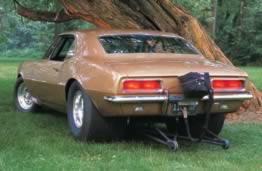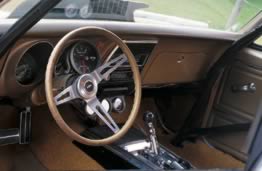Do you believe in fate—the idea that someone or something is out there shaping your destiny? Being worldly types, we used to equate fate with astrology, Ouiji boards, and Miss Cleo the TV psychic.
But Ed Parker has changed that. He’s a respectable citizen by day, running a company that stripes asphalt parking lots in the greater Columbus, OH area. But on the weekends, he turns into “Fast Eddie,” and tears up asphalt a quarter mile at a time in an eight-second, street-legal 1967 Camaro.
Need more proof that this man’s destiny is controlled by a higher power? Ed competed in the Ohio’s Fastest Street Car Shootout at Norwalk Raceway Park in 2001, where he was runner-up to event winner Gary Box. This past April, the two squared off again at Norwalk’s United States Fastest Street Car Shootout (same race, new name-ed.). This time, it was Ed who tripped the win lights first to earn the title America’s Fastest Street Car. If that isn’t fate, we don’t know what is.
Even Ed admits that his life was preordained.
“I was just born with it,” he said about his hot rod jones. “My father is an electrical engineer who doesn’t care about cars at all. Heck, my brother is a golf pro who can’t even change a tire!”
Ed has owned a number of hot cars, including a 427/425 horse ’68 Impala, a Super Gas Vega, various first-gen Z28s—even a 1977 Chevette with a 383 small block that runs in the 12s. But nothing compares to his current Camaro, a 39,000 original mile SS/RS that had been a race car from the day it rolled off the dealer’s lot.
“I bought the car locally—it had just two previous owners,” Ed said. “I had always wanted it, but I had to wait until 1992 to buy it. The body and paint are original—the windows have never been out, and the front clip and doors have never been off the car.”
The same can’t be said for the chassis and drivetrain, though. John Holt Race Cars fabricated a four-link backhalf and a 10-point chromemoly roll cage for the Camaro. A custom nine-inch Ford rear axle with Moser axles and 4.11 gears hangs in place of the original GM 12-bolt, and the stock front suspension has Moroso race springs and Koni shocks.
Under the hood is 632 cubic inches of Donovan big block Chevy. Built by Scott Shafiroff, the engine features a huge .833-inch lift Crane solid roller cam, ported Dart Big Chief heads with Jesel shaft rockers, a sheetmetal intake with twin 1,320 cfm Dominator-style carbs, and a single stage NOS Fogger nitrous setup. The engine puts 1,140 horsepower and 960 foot-pounds of torque to the 33 x 18.5-15 Mickey Thompson ET Street tires–enough moxie to put the Camaro consistently in the low eights at over 170 miles per hour.
So what does fate have in store for Ed Parker? It apparently wants him to go even quicker and faster, ’cause he’s building a 1969 Camaro to run in the Outlaw 10½-inch tire class. We think fate is in for one heck of a ride.
FAST SPECS
Chassis
Frame: Stock front subframe, custom 2- x 3-inch tube backhalf and 10-point roll cage
Front Suspension: Stock A-arm with Moroso Trick Front Springs, Koni shocks
Rear Suspension: Custom 4-link with Koni shocks, custom stabilizer bar and wheelie bars
Rear Axle: Custom 9-inch Ford with Moser axles, 4.11 ring and pinion
Brakes: Strange 4-wheel disc brakes
Wheels and Tires: Weld Racing Aluma-Star wheels (15 x 3 1⁄2 front, 15 x 16 rear), Mickey Thompson ET Street tires (33 x 18.5-15) and Mickey Thompson Sportsman Front tires
Chassis Work: John Holt Race Cars
Engine and Transmission
Type: 632 cubic inch big block Chevy, 1,140 horsepower/960 ft.-lbs. torque
Block: Donovan 500
Reciprocating Assembly: Cullys steel crank, Scott Shafiroff 6.800″ aluminum rods, Ross 14.5:1 forged pistons
Camshaft: Crane Cams solid roller cam, .833-inch lift
Cylinder Heads: Dart Big Chief aluminum heads, fully ported by Scott Shafiroff
Valvetrain: Jesel shaft roller rockers, Comp Cams valve springs and retainers, 2.40-inch/1.94-inch titanium valves
Induction: Custom sheetmetal intake manifold, dual 1,320 cfm Dominator style carburetors, 350 horsepower NOS Fogger nitrous system with NOS progressive nitrous controller
Ignition: MSD Pro Billet distributor, MSD 7AL ignition, MSD Blaster coil, MSD ignition wires
Exhaust: 2 1⁄4-inch to 2 3⁄8-inch step headers, 4 1⁄2-inch dual exhaust and Flowmaster mufflers, custom-made by John Holt Race Cars
Transmission: Powerglide with TCI manual valve body and 4,200 rpm converter
Paint and Body
Body Modifications: 6-inch fiberglass cowl induction hood
Bodywork and Paint: General Motors
Interior
Seats: Lightened stock bucket seats, rear seat removed
Upholstery: Stock gold upholstery and carpet
Gauges: Auto Meter
Upholstery Work: Patty Parker
Crew
Bill Greely, Craig Massie, Dave Ruark, Brenda Reisling
Special Thanks To: Ben and Andy Holt







Comments